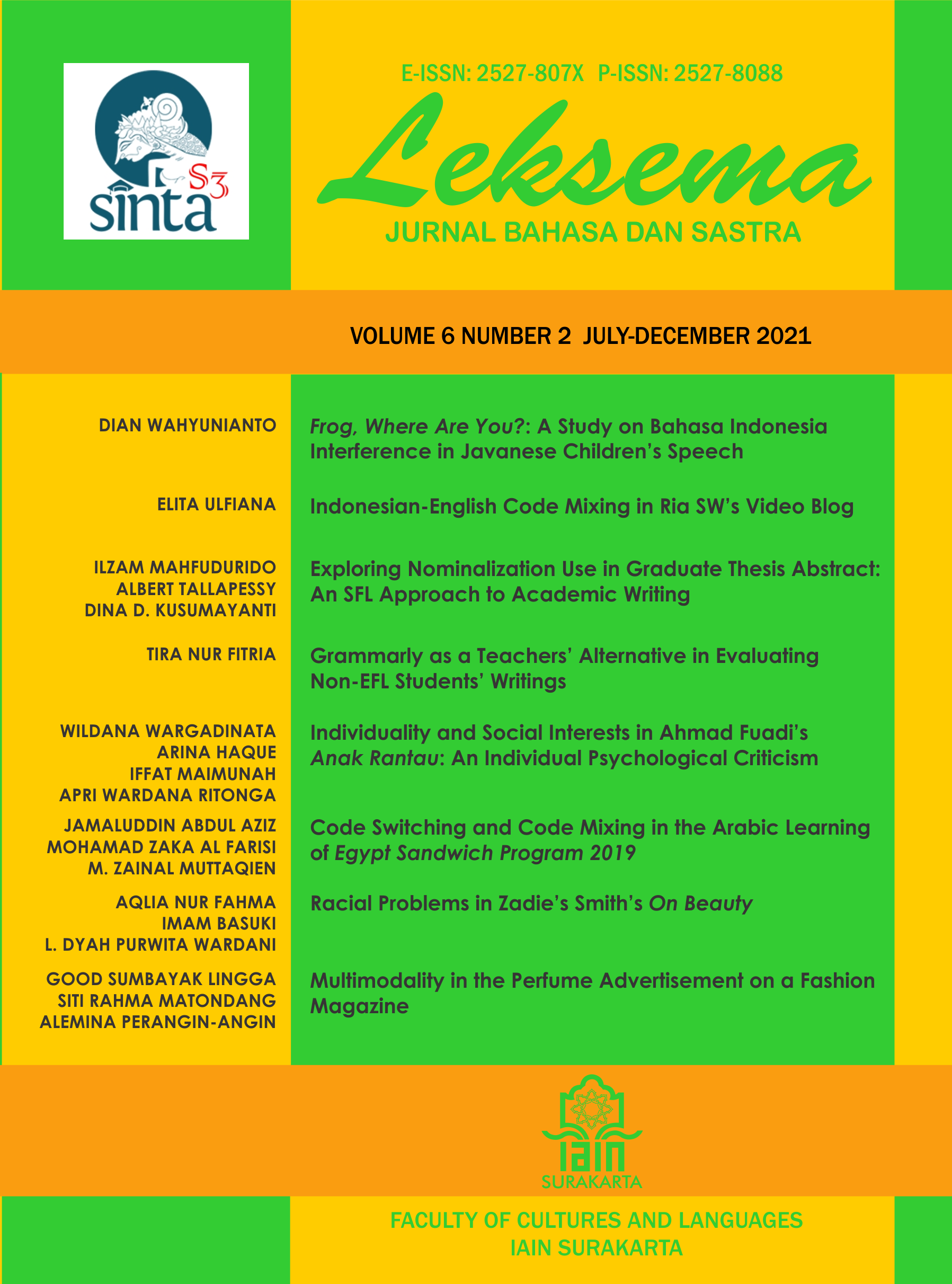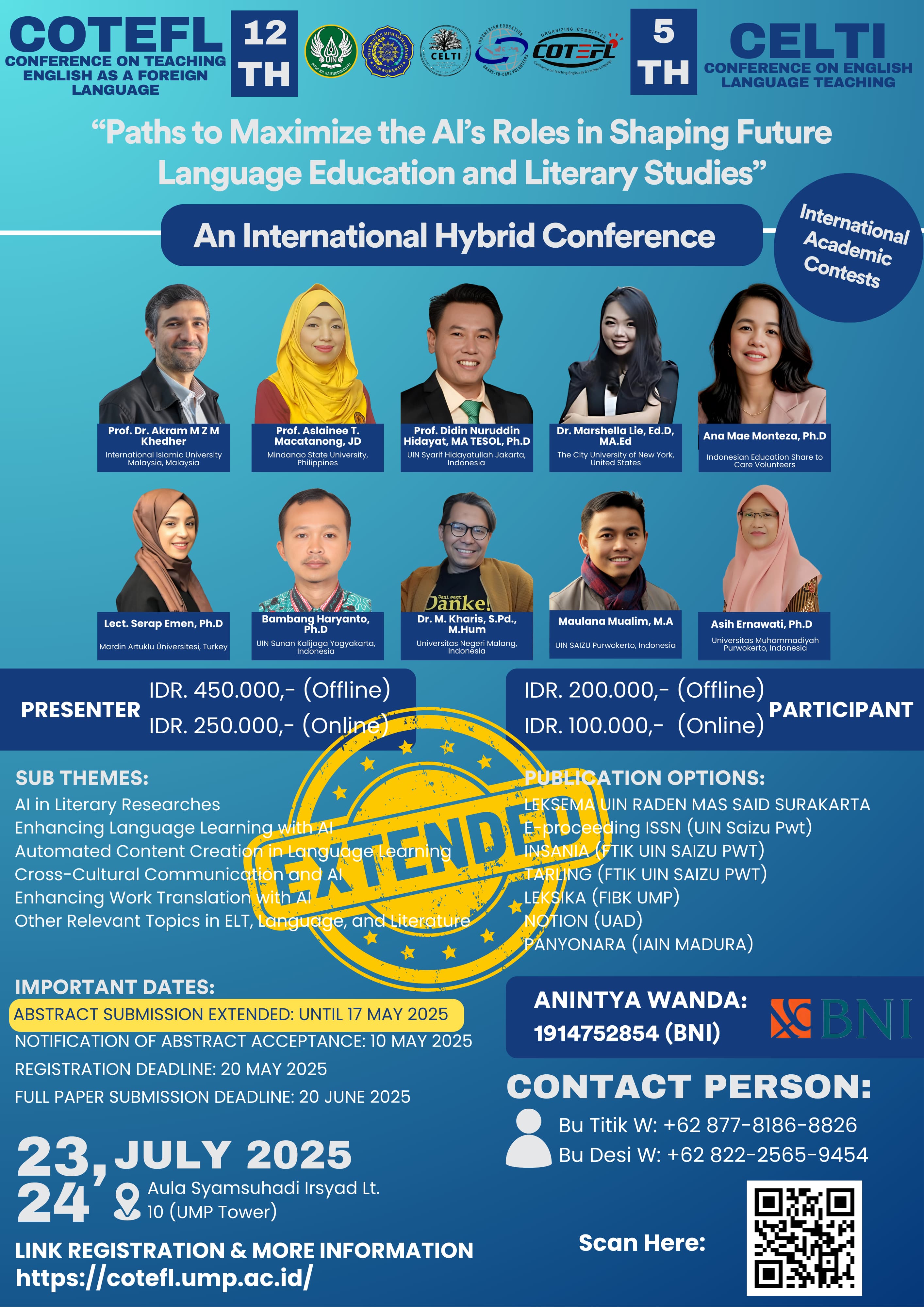'FROG, WHERE ARE YOU?': A STUDY ON BAHASA INDONESIA INTERFERENCE IN JAVANESE CHILDREN'S SPEECH
DOI:
https://doi.org/10.22515/ljbs.v6i2.3628Keywords:
bilingualism, language contact, language interference, Bahasa Indonesia, JavaneseAbstract
The coexistence of Bahasa Indonesia and Javanese has become an issue in the Javanese language preservation. Such strong contact is finally resulting in bilingual individuals in which language interference often occur. In this study, however, is aiming at describing how and why Bahasa Indonesia is interfering Javanese in Javanese children speech. By using task-based approach by Grosjean, this study manipulated language production in Javanese children using wordless narrative book Frog, Where Are You? created by Mercer Mayer. The results show that Bahasa Indonesia is interfering Javanese in phonic, morphological, syntactic, lexical, and even semantic aspects. Nevertheless, lexical level interference is the most noticeable interference since both language share quite similar structure. It is believed that, in sociolinguistics perspective, Bahasa Indonesia has gradually shift Javanese gradually. It is also seen that Javanese children with strong exposure of Bahasa Indonesia are eventually perceive more Bahasa Indonesia structure than Javanese.Downloads
References
Anderson, Ben. 1966. “The Languages of Indonesian Politics.†Indonesia 1 (1): 89. https://doi.org/10.2307/3350786
Ardila, Regina Rendi, Ansellyta Agustine & Rosi Rosi. 2018. “Analisis Tingkat Interferensi Bahasa Indonesia Pada Anak Usia 12 Tahun Berdasarkan Perbedaan Latar Belakang Bahasa Orang Tua.†Parole: Jurnal Pendidikan Bahasa dan Sastra Indonesia 1 (4): 651–58. http://journal.ikipsiliwangi.ac.id/index.php/parole/article/view/1079
Arua, Arua E & Keoneng Magocha. 2002. “Patterns of Language Use and Language Preference of Some Children and Their Parents in Botswana." Journal of Multilingual and Multicultural Development 23 (6): 449-61. https://doi.org/10.1080/0143463020 8666479
Baroroh, Kamilatun. 2020. “Possessive Expressions in Javanese.†International Journal of Cultural and Art Studies 04 (1): 42-53
Baykalova, Elena D, Mira K Artyna, Namdolmaa S Dorzhu, Taigana K Ochur, & Dolaana S. Mongush. 2018. “Morphological Interference in the Process of Mastering English Speech in Conditions of Interaction of Tuvan, Russian and English as a Foreign Language.†Opcion 34 (85-2): 35-60
Bennett-Kastor, Tina. 2002. “The Frog Story Narratives of Irish-English Bilinguals.†Bilingualism: Language and Cognition 5 (2): 131-46. https://doi.org/10.1017/s1 366728902000238
Bondarko, Liya V. 2000. “Language Contact: Phonetic Aspect.†Studies in Slavic and General Linguistics 28: 55-65
Caldas, Stephen J, & Suzanne Caron-Caldas. 2002. “A Sociolinguistic Analysis of the Language Preferences of Adolescent Bilinguals: Shifting Allegiances and Developing Identities.†Applied Linguistics 23 (4): 490-514+549. https://doi.org/10.1093/applin/ 23.4.490
Cameron, Catherine Ann & Min Wang. 1999. “Frog, Where Are You? Children’s Narrative Expression over the Telephone.†Discourse Processes 28 (3): 217-36. https://doi.org/ 10.1080/01638539909545082
Cohn, AC & M Ravindranath. 2014. “Local Languages in Indonesia: Language Maintenance or Language Shift?†Linguistik Indonesia 32 (2): 131-48
Davies, William D & Craig A Dresser. 2005. “The Structure of Javanese and Madurese Determiner Phrases.†Austronesian Formal Linguistics Association (AFLA) 12 (12): 57-72
Dornyei, Zoltan. 2007. Research Method in Applied Linguistics. Oxford: Oxford University Press
Fishman, Joshua A. 1968. “Sociolinguistic Perspective on the Study of Bilingualism.†Linguistics 6 (39): 21-49. https://doi.org/10.1515/ling.1968.6.39.21
Hennessey, Judith E, Theodore S Bell & Robert J. Kwortnik. 2005. “Lexical Interference in Semantic Processing of Simple Words: Implications for Brand Names.†Psychology and Marketing 22 (1): 51-69. https://doi.org/10.1002/mar.20046
Hidayat, Rahmat & Teguh Setiawan. 2015. “Interferensi Bahasa Jawa Ke Dalam Bahasa Indonesia Pada Keterampilan Berbicara Siswa Negeri 1 Pleret, Bantul.†LingTera 2 (2): 156-68. https://doi.org/10.21831/lt.v2i2.7374
Ilbek, Jacques. 1967. “A Case of Semantic Interference.†The French Review 41 (3): 368–76. citeulike-article-id:895838%5Cnhttp://www.jstor.org/stable/385167
Kartikasari, Ratna Dewi. 2019. “Penggunaan Bilingualisme pada Masyarakat Yang Berwirausaha.†Pena Literasi: Jurnal Pendidikan Bahasa Dan Sastra Indonesia 2 (1): 47–54. https://doi.org/10.24853/pl.2.1.47-54
Kharkhurin, Anatoliy V. 2007. “The Roleof Cross-Linguistic ad Cross-Cultural Experences in Bilinguals' Divergent Thinking.†In Istvan Kecskes & Liliana Albertazzi (eds.) Cognitive Aspects of Bilingualism, 175-210. Dordrecht: Springer. https://doi.org/10.1007/978-1-4020-5935-3
Kundharu, Saddhono. 2006. “Bahasa Etnik Madura di Lingkungan Sosial: Kajian Sosiolinguistik di Kota Surakarta.†Kajian Linguistik dan Sastra 18 (34). https://doi.org/https://doi.org/10.23917/kls.v18i1.5124
Luykx, Aurolyn, Okhee Lee, Margarette Mahotiere, Benjamin Lester, Juliet Hart & Rachael Deaktor. 2007. “Cultural and Home Language Influences on Children’s Responses to Science Assessments.†Teachers College Record 109 (4): 897-926
Mahon, Bradford Z, Albert Costa, Robin Peterson, Kimberly A. Vargas & Alfonso Caramazza. 2007. “Lexical Selection Is Not by Competition: A Reinterpretation of Semantic Interference and Facilitation Effects in the Picture-Word Interference Paradigm.†Journal of Experimental Psychology: Learning Memory and Cognition 33 (3): 503-35. https://doi.org/10.1037/0278-7393.33.3.503
Mardikantoro, Hari Bakti. 2012. “Pergeseran Bahasa Jawa dalam Ranah Keluarga pada Masyarakat Multibahasa di Wilayah Kabupaten Brebes.†Humaniora 19 (1): 43-51. https://doi.org/10.22146/jh.v19i1.890
Mariyana, Lisna. 2011. Bahasa Indonesia dalam Bahasa Jawa di Cakra Semarang TV.
Mayer, Mercer. 1969. Frog, Where Are You? New York: Dial Books for Young Readers
Minami, Masahiko. 2002. Culture-Specific Language Styles: The Development of Oral Narrative and Literacy. Edited by Li Wei. Clevedon: Multilingual Matters Ltd. https://doi.org/10.1017/CBO9781107415324.004
Minami, Masahiko. 2005. “Bilingual Narrative Development in English and Japanese—A Form/Function Approach.†ISB4: Proceedings of the 4th International Symposium on Bilingualism, 1618–29. http://www.lingref.com/isb/4/128ISB4.PDF
Mulyani, Wahyu. 2014. “Interferensi Leksikal Bentuk Dasar Bahasa Jawa Tuban Dalam Bahasa Indonesia: Suatu Tinjauan Deskriptif.†Bastra 1 (2): 133-0.
Munandar, Aris. 2013. “Pemakaian Bahasa Jawa dalam Situasi Kontak Bahasa Di Daerah Istimewa Yogyakarta.†Humaniora 25 (1): 92-102. https://jurnal.ugm.ac.id/jurnal-humaniora/article/view/1819
Nugroho, Miftah. 2011. “Bahasa Indonesia atau Bahasa Jawa Pilihan Orang Tua dalam Berinteraksi dengan Anak di Rumah.†International Seminar: Language Maintenance and Shift July 2, 2011: 198-202
Paradis, Michael. 2005. “Aspects and Implications of Bilingualism.†In Judith F. Kroll and Annette M. B. De Groot (eds.) Handbook of Bilingualism: Psycholinguistic Approach, 411-16. New York: Oxford University Press
Poedjosoedarmo, Gloria. 2006. “The Effect of Bahasa Indonesia as a Lingua Franca on the Javanese System of Speech Levels and Their Functions.†International Journal of the Sociology of Language 177 (177): 111–21. https://doi.org/10.1515/ijsl.2006.007
Poerwadarminta, WJS. 1939. Baoesastra Djawa. Batavia: JB Wolters Groningen
Prawiroatmodjo, S. 1981. Bausastra Jawa-Indonesia (2nd ed). Gunung Agung
Purwadi. 2004. Kamus Jawa-Indonesia/Indonesia-Jawa. S Maziyah (ed). Yogyakarta: Bina Media
Raettig, Tim, & Sonja A. Kotz. 2008. “Auditory Processing of Different Types of Pseudo-Words: An Event-Related FMRI Study.†NeuroImage 39 (3): 1420-28. https://doi.org/10.1016/j.neuroimage.2007.09.030
Reilly, Judy, Molly Losh, Ursula Bellugi & Beverly Wulfeck. 2004. “Frog, Where Are You? Narratives in Children with Specific Language Impairment, Early Focal Brain Injury, and
Williams Syndrome.†Brain and Language 88 (2): 229–47. https://doi.org/10.1016/S0093-934X(03)00101-9
Republik Indonesia. 2009. Undang-Undang Republik Indonesia No. 24 Tahun 2009 Tentang Bendera, Bahasa, Dan Lambang Negara, Serta Lagu Kebangsaan (Law No. 24 of 2009 on the National Flag, Language, Emblem and Anthem)
Sarfraz, Summaira, Zahida Mansoor & Raheela Tariq. 2016. “Analysis of Grammatical Interference and Its Social Acceptability in Pakistani Context.†Procedia: Social and Behavioral Sciences 232 (April): 684-88. https://doi.org/10.1016/j.sbspro.2016.10.093
Schmid, Peggy M & Grace H Yeni-Komshian. 1999. “The Effects of Speaker Accent and Target Predictability on Perception of Mispronunciations.†Journal of Speech, Language, and Hearing Research 42 (1): 56-64. https://doi.org/10.1044/jslhr.4201.56
Soderberg, Craig D & Kenneth S Olson. 2008. “Indonesian.†Journal of the International Phonetic Association 38 (2): 209-13. https://doi.org/10.1017/S0025100308003320
Starreveld, Peter A & Wido La Heij. 1995. “Semantic Interference, Orthographic Facilitation, and Their Interaction in Naming Tasks.†Journal of Experimental Psychology: Learning, Memory, and Cognition 21 (3): 686-98. https://doi.org/ 10.1037/0278-7393.21.3.686
Subroto, Edi. 2007. Pengantar Metode Penelitian Linguistik Struktural. Surakrata: UNS Press
Sudaryanto. 1979. Predikat-Objek Dalam Bahasa Indonesia Keselarasan Pola Urutan. Yogyakarta: Djambatan
Sukoyo, Joko. 2012. “Interferensi Bahasa Indonesia dalam Acara Berita Berbahasa Jawa Kuthane Dhewe di TV Borobudur Semarang.†Lingua 7 (2): 95-103
Walters, Joel. 2005. Bilingualism: The Sociopragmatic-Psycholinguistic Interface. Mahwah, New Jersey: Lawrence Erblaum Associates, Inc.
Wei, Li. 2009. “Research Perspectives on Bilingualism and Multilingualism.†In Li Wei &
Melissa G Moyer (eds.). The Blackwell Guide to Research Methods in Bilingualism and Multilingualism, 3–17. Massachusetts: Blackwell Publishing. https://doi.org/10.1002/ 9781444301120
Weinreich, Uriel. 1968. Languages in Contact: Findings and Problems. The Hague: Mouton Publisher
Downloads
Published
Issue
Section
License
Copyright (c) 2021 LEKSEMA: Jurnal Bahasa dan Sastra

This work is licensed under a Creative Commons Attribution-NonCommercial-ShareAlike 4.0 International License.
The copyright of the received article shall be assigned to the publisher of the journal. The intended copyright includes the right to publish the article in various forms (including reprints). The journal maintains the publishing rights to published articles.
In line with the license, the authors and users (readers or other researchers) are allowed to share and adapt the material only for non-commercial purposes. In addition, the material must be given appropriate credit, provided with a link to the license, and indicated if changes were made. If authors remix, transform or build upon the material, authors must distribute their contributions under the same license as the original.







